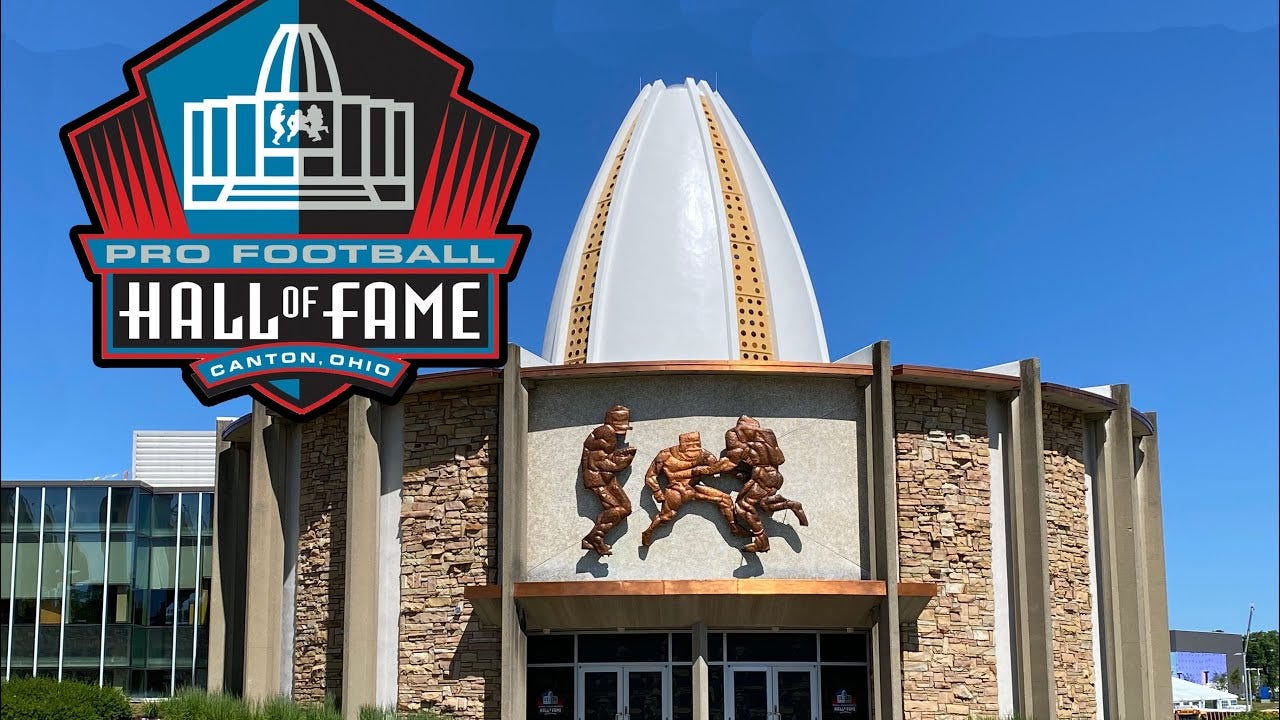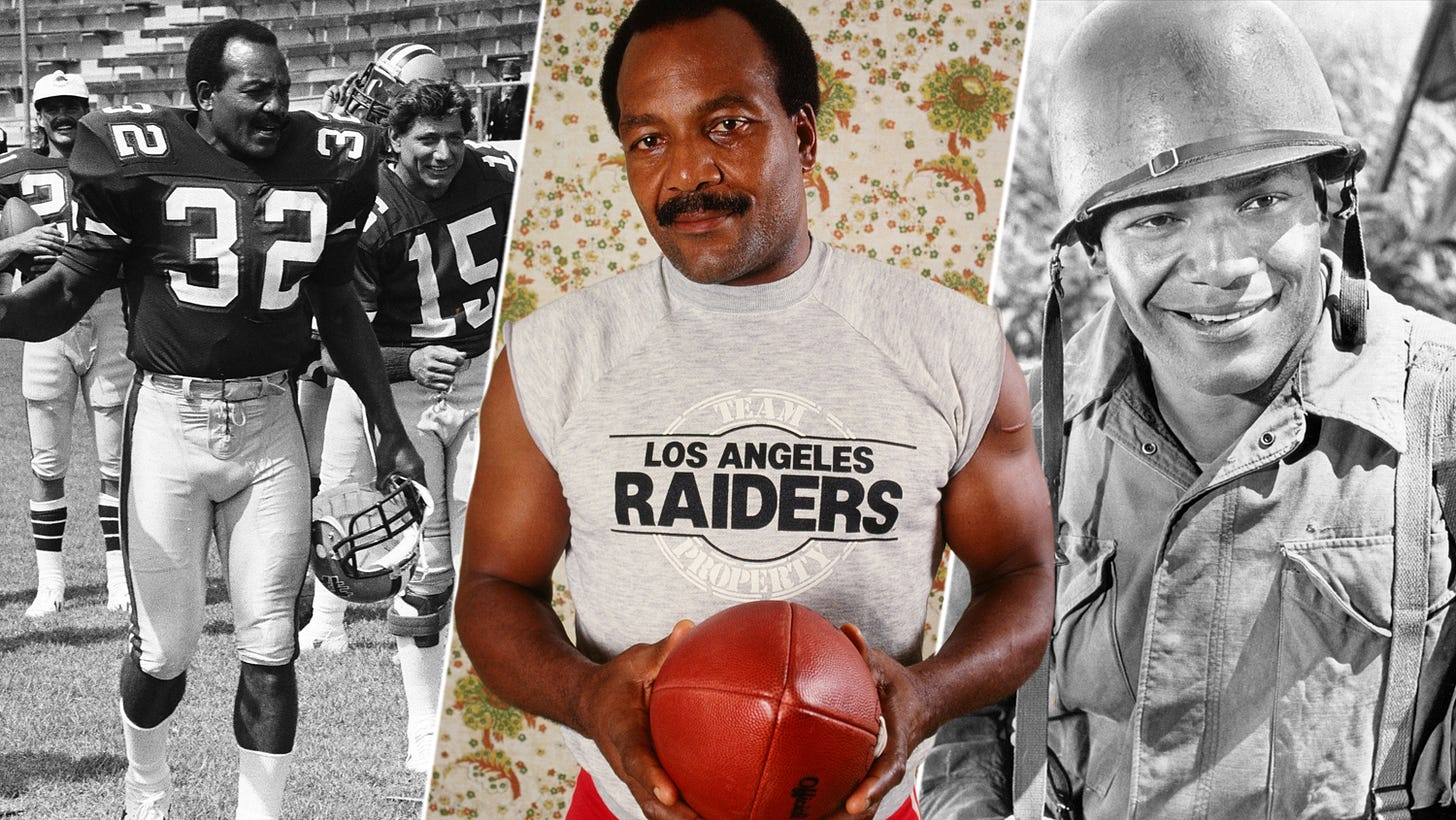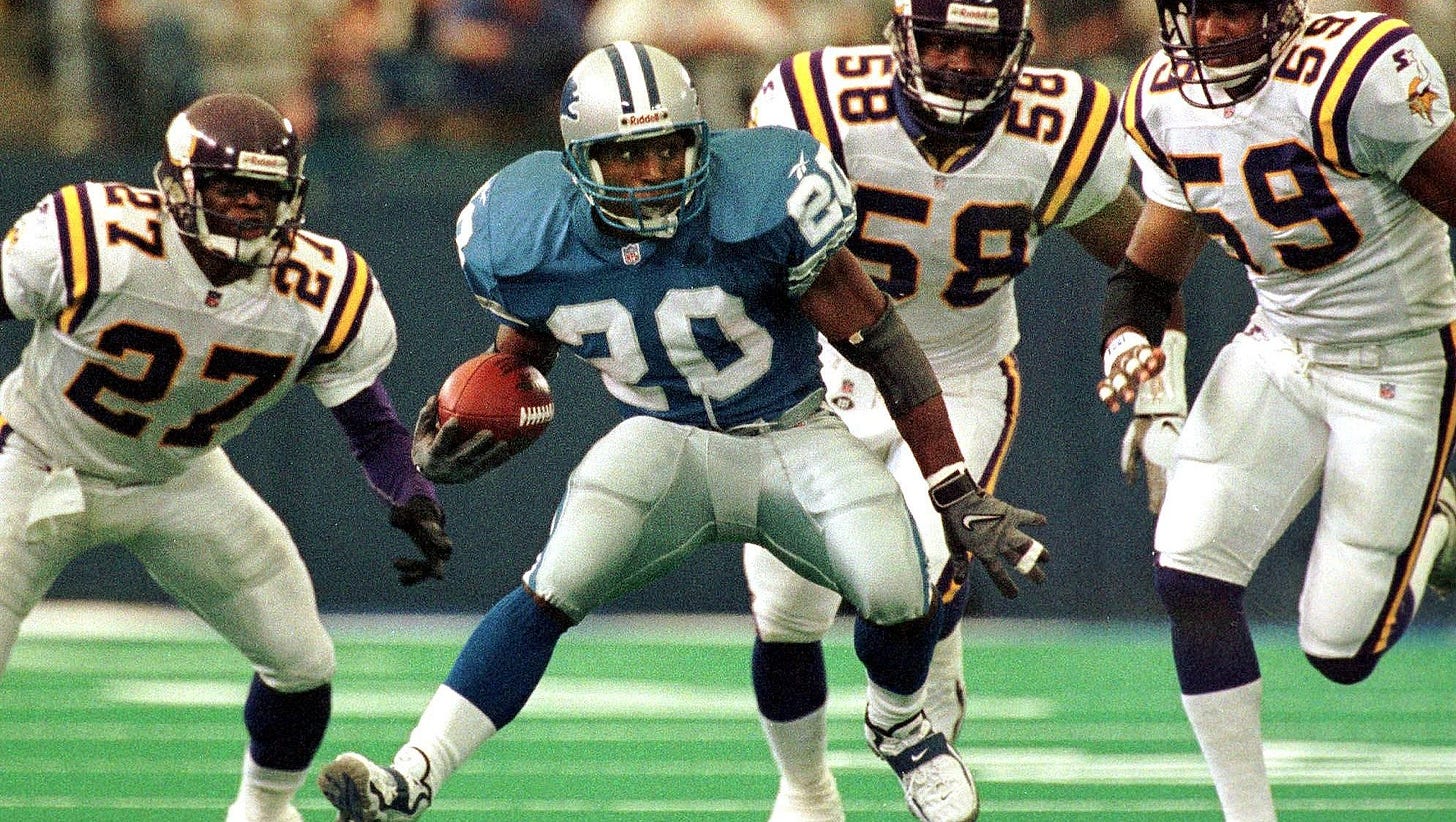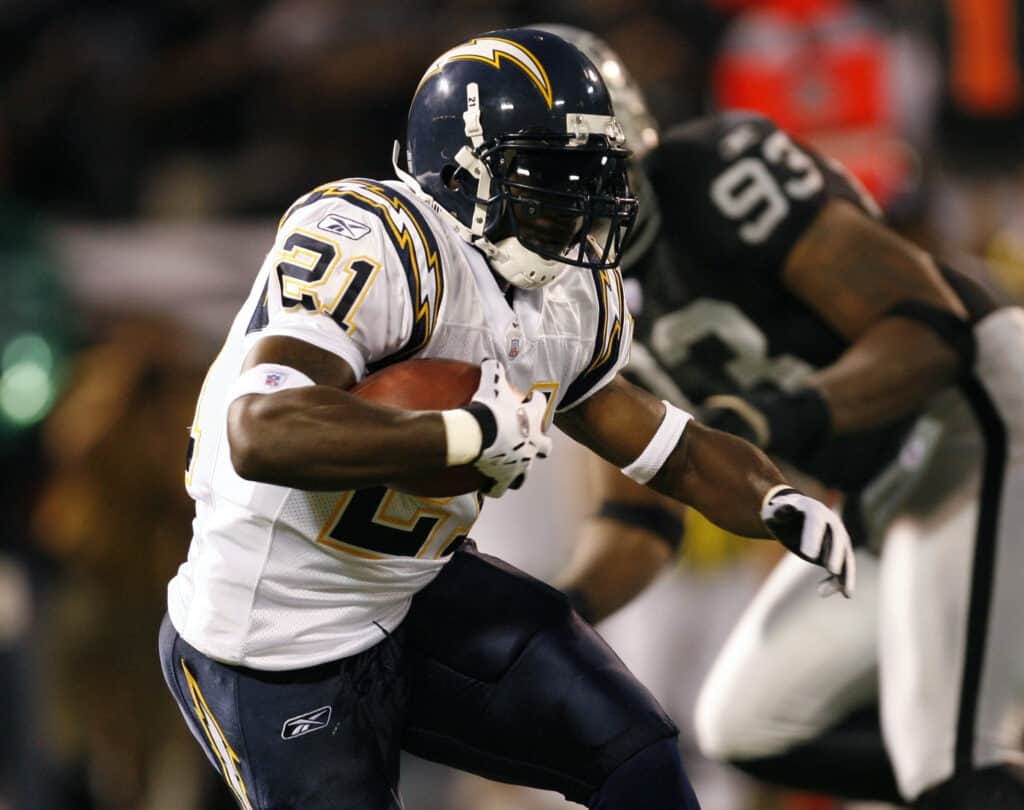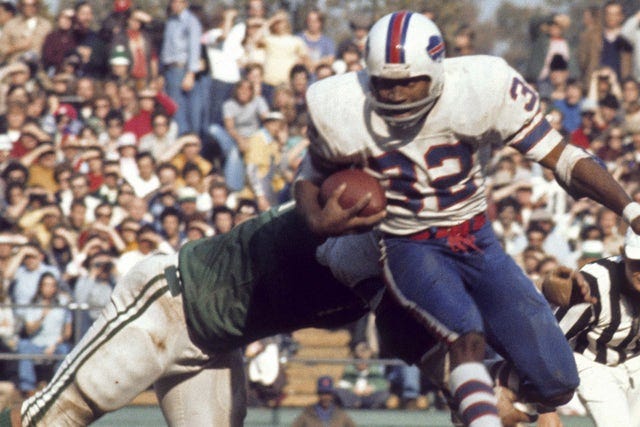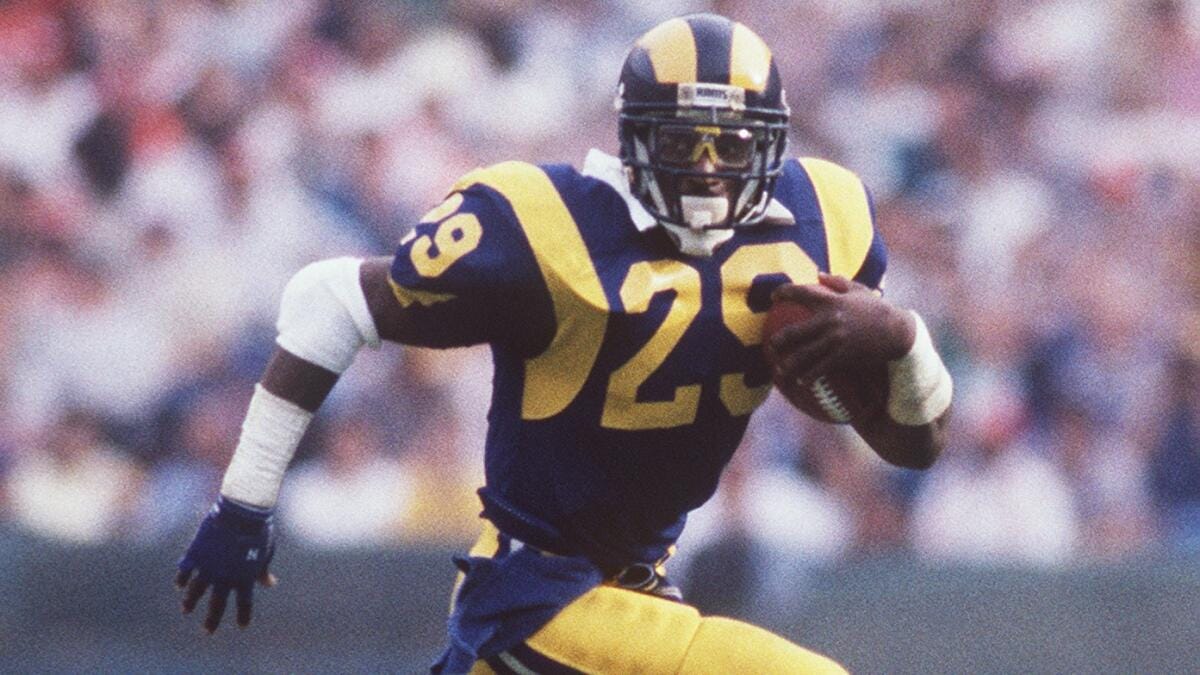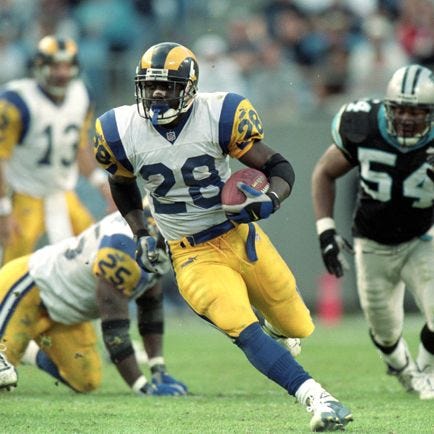Chasing Canton, Series: Hall of Fame Running Backs Who Set the Standard
Jeremy Bissett Part One: Top ten running backs based on Hall of Fame Monitor Scoring.
I was digging through some stats and got a little shocked when I saw where Christian McCaffrey ranks all-time compared to running backs already in the Pro Football Hall of Fame. That got me curious enough to take a deeper look at other players, and I figured this would be a perfect topic to kick off our Think Tank series. This section is where you'll find ideas and insights that don’t really fit anywhere else here at The Bissett Perspective—but we still want to share them somewhere, so why not the Think Tank? Makes sense, right?
Here you will find the first part that only covers the top 10 HOF running backs based on their Hall of Fame Moniter Scroing System. In the second part we wil deep dive the running backs who are either eligible or soon entering their eligibility window. Along with the curious case of Lorenzo Neal who is hands down the most selfless player who deserves the recognition of playing the fullback position at a Hall of Fame level. Lastely, who are the active running backs that may make a case for a Gall of fame bid? Make sure to check back for the second part of this mini series!
🏈🏈🏈🏈🏈🏈🏈🏈🏈🏈🏈🏈🏈🏈
Welcome to Part One of the Chasing Canton series: RB Edition. When you think about legendary running backs, the mind jumps straight to the Hall of Fame—those bronze busts in Canton, the iconic moments replayed every Sunday, and names that feel stitched into the fabric of football itself. These aren’t just stat machines; they’re the backs who forced defenses to tap out, made fans stand up and shout, and set a new standard for what greatness looks like at the position. But what exactly does it take to earn a place among the NFL’s immortals? In this first part, we’re spotlighting the ten running backs who set the bar—already enshrined in Canton—ranked by their Hall of Fame Monitor scores. Their stories are more than just numbers; they’re about the moments that made jaws drop and the legacies that still shape the game.
The Hall of Fame Standard Setters
The greatest running backs in NFL history aren’t just measured by numbers. They’re defined by the moments when the whole stadium sucked in its breath, when a single cut or stiff-arm sent a ripple through living rooms across the country. The Hall of Fame Monitor tries to boil all this down into a formula—stats, awards, longevity—but the truth is, greatness is always more than a sum of parts. The legends who set the standard for Canton have careers that read like epic novels, full of triumphs, heartbreaks, and chapters written far from the glare of stadium lights. Lets take a look at the top 10 HOFm scorers at the running back position.
Walter Payton: Sweetness and Steel (HOFm 214.61)
Long before Walter Payton was running through defenses, Gale Sayers set the standard for what a Chicago Bears running back could be. “The Kansas Comet” dazzled fans with his speed and effortless moves, scoring six touchdowns in one game as a rookie and making defenders miss in ways that still show up on highlight reels. Sayers’ brilliance, though brief, carved out a legacy of artistry at the running back position—a legacy Payton would build on and redefine.
Payton, known as “Sweetness,” finished his 13-year career with a then-record 16,726 rushing yards and 110 rushing touchdowns. But the numbers only begin to tell the story. Payton was famous for hurdling defenders, never running out of bounds, and bringing a mix of toughness and style to every carry. “Never die easy,” he’d say—and he lived it. Coaches and peers marveled at his endurance and willpower; Jim Brown, no stranger to greatness, once said, “Give me the heart of Walter Payton. There’s never been a greater heart.”
When Chicago sports fans talk about legendary “Flu Games,” Michael Jordan’s heroic performance in Game 5 of the 1997 NBA Finals usually tops the list. Battling illness, Jordan poured in 38 points to will the Bulls to victory against the Utah Jazz. But in NFL circles, there’s another flu game that stands just as tall: Walter Payton’s 275-yard explosion against the Minnesota Vikings in 1977. Sick and struggling on the sidelines, Payton returned to the field again and again, shredding the division rivals for a single-game rushing record that stood for decades. It was a testament not just to his talent but to his refusal to quit.
For Payton, every snap was a chance to inspire teammates, challenge opponents, and show fans what heart really looked like. His legacy isn’t just in the Hall of Fame or the Man of the Year award that bears his name—it’s in the standard of effort, humility, and greatness he set every time he took the field.
Jim Brown: Relentless Force (HOFm 182.79)
If Walter Payton was poetry in motion, Jim Brown was a runaway locomotive—blasting through defenses with a mission to deliver the ball to the end zone, and determined not to be stopped until he got there. For those who didn’t get to witness Brown live, imagine a more dominant, relentless version of Derrick Henry: bigger than most linebackers, faster than many receivers, and never one to shy away from contact. In just nine seasons with the Cleveland Browns, Brown bulldozed his way to 12,312 rushing yards and 126 touchdowns—numbers that still command respect in the NFL record books. He led the league in rushing eight times, made nine Pro Bowls, and earned three MVP awards, overwhelming defenders from his very first carry to his last.
You didn’t need to catch every game to feel his impact. The highlights speak for themselves: two different games with 237 rushing yards, and a five-touchdown masterpiece against the Baltimore Colts in 1959. Tackling Brown was like colliding with a freight train—he’d take the hit, rise slowly, and make defenders pay the next play. “Showing weakness will encourage your opponents,” he once said, and he never gave them the satisfaction. Coaches, teammates, and rivals all knew Brown could flip a game’s momentum instantly; Paul Brown himself called him “the greatest football player I’ve ever seen.”
Off the field, Brown’s influence was just as powerful. He became a champion for civil rights, mentoring young athletes and using his platform to push for social change. Retiring at 30, still at the height of his powers, Brown stepped away on his own terms—a move almost unheard of for a superstar. Whether powering through defenses or breaking barriers beyond football, Jim Brown’s legacy is one of relentless force, leadership, and a greatness that still shapes every conversation about the best to ever play the game.
Barry Sanders: The Magician (HOFm 177.55)
If there was ever a time a professional athlete embodied the phrase, "Act like you’ve been there before, and know you’ll be there again," it was Barry Sanders. In today’s era of TikTok celebrations and end zone theatrics, Sanders scored touchdowns with a simple nod to humility—handing the ball to the referee and jogging quietly back to the sideline, never asking for the spotlight. For all the flash he brought with his feet, his demeanor was the exact opposite. And that’s part of why his abrupt retirement, still in his prime and just shy of the all-time rushing record, remains a shock for Detroit Lions fans.
The ultimate “what if” still hangs in the air: What if Sanders was able to run behind the legendary Dallas Cowboys offensive line? Would we even have the same jaw-dropping highlight reel, or would he have shattered every record in sight—maybe even flirted with a 3,000-yard season? Luckily for Emmitt Smith, he never had to navigate the patchwork Lions front, while fans got to marvel at Barry spinning defenders in circles, turning every handoff into a game of “where did he go?” as he weaved his way to the end zone.
For 10 seasons in Detroit, Sanders was a magician with the ball—racking up 15,269 rushing yards, 99 touchdowns, and a vault of jaw-dropping runs that still feel unreal years later. He topped 1,000 rushing yards in every season he played, despite rarely having the luxury of a dominant offensive line or much help from the rest of the offense. His 2,053-yard campaign in 1997, averaging over six yards per carry, is still considered one of the greatest seasons ever for any running back.
Ask anyone who saw him, and they’ll point to games like his 237-yard masterpiece against Tampa Bay or the famous run against the Patriots in 1994, where he reversed direction three times and left defenders sprawled across the field. Every time he touched the ball, you felt like something extraordinary could happen. Detroit’s coaches knew better than to overthink it—Wayne Fontes once said, “You can’t coach what Barry does. You just give him the ball and get out of the way.” Even Hall of Fame linebacker Mike Singletary admitted, “You just hoped to get a piece of him.”
Emmitt Smith: The Relentless Champion (HOFm 176.48)
Emmitt Smith was the steady, pounding heartbeat of the Dallas Cowboys’ legendary offensive trio, sharing the spotlight with quarterback Troy Aikman and wide receiver Michael Irvin. While Sanders dazzled with highlight-reel magic and Jim Brown bulldozed through history, Smith made his mark by relentlessly grinding out yards, eating up the clock, and delivering in the moments that counted most. He may not have had the flash, but he embodied the soul of a champion—never more so than on January 2, 1994, in a game that has become Cowboys lore.
Facing the New York Giants with the NFC East title on the line, Smith suffered a separated shoulder in the second quarter. Instead of bowing out, he carried the ball 32 times for 168 yards and caught 10 passes for another 61, powering Dallas to an overtime win and the division crown. That game helped propel the Cowboys to a second straight Super Bowl and cemented Smith’s reputation as the player you wanted when everything was on the line.
Over 15 seasons, mostly with the Cowboys, Smith became the NFL’s all-time leading rusher, finishing with 18,355 yards and a record 164 rushing touchdowns. He won three Super Bowls and took home MVP honors in Super Bowl XXVIII.
LaDainian Tomlinson: The Touchdown Machine (HOFm 136.50)
Tomlinson burst onto the scene right around the time fantasy football commissioners were transitioning from tracking stats in newspapers to managing real-time online leagues—and it was a perfect match. His eye-popping numbers demanded attention, earning him Offensive Rookie of the Year honors and launching a career that featured nine straight seasons with double-digit rushing touchdowns. His 2006 campaign stands as one of the greatest ever: 31 total touchdowns, including a record-setting 28 rushing scores. Nearly two decades later, that feat remains unmatched, with the closest challenger being Raheem Mostert, who finished with 18 rushing touchdowns in 2023.
By the time Tomlinson arrived, the league had already seen versatile backs like Roger Craig and Marshall Faulk, players who could run, catch, and change the game. It’s quite possible that if you took the DNA of both of those stars and combined them, you’d get LT—an electrifying blend of power, speed, and receiving ability that made him a matchup nightmare.
By the time LT retired after 11 seasons, primarily with the San Diego Chargers, he ranked as the NFL’s fifth all-time leading rusher with 13,684 yards. He also piled up 145 rushing touchdowns. Add in 624 receptions for 4,772 yards and 17 receiving touchdowns, and it's clear why defenses always had to game plan specifically for him.
Tomlinson’s 2006 season remains his masterpiece. That year, he not only set the NFL single-season record for rushing touchdowns but also scored 186 points overall. He rushed for 1,815 yards and became the fastest player in league history to reach major touchdown and yardage milestones.
It’s crazy to think that LaDainian Tomlinson never played in a Super Bowl, especially considering the Chargers hit a home run with their first two picks in the 2001 draft—selecting Tomlinson fifth overall and quarterback Drew Brees in the second round. Tomlinson was inducted into the Pro Football Hall of Fame in his first year of eligibility, and the Chargers retired his No. 21 jersey.
O.J. Simpson: The First 2,000-Yard Man (HOFm 135.98)
O.J. Simpson’s football career began with a stellar college run that culminated in winning the 1968 Heisman Trophy, setting the stage for an impactful NFL career—one that would forever be overshadowed by later events in his life. Selected as the first overall pick by the Buffalo Bills in the 1969 NFL/AFL Draft, Simpson quickly made his mark on the league. In 1973, he became the first player in NFL history to rush for over 2,000 yards in a single season, finishing with 2,003 yards and earning the NFL Most Valuable Player award.
Simpson dominated the league throughout the 1970s, leading the NFL in rushing yards four times (1972, 1973, 1975, and 1976), earning five consecutive First-Team All-Pro selections from 1972 to 1976, and being chosen to six Pro Bowls. For his career, which ended in 1979, Simpson rushed for 11,236 yards and scored 61 touchdowns, and he was inducted into the Pro Football Hall of Fame in 1985, his first year of eligibility.
Teammates admired his work ethic and natural talent, with many recalling how Simpson seemed to glide effortlessly past defenders. Coaches praised his speed and toughness, noting his ability to change the course of a game with a single run. Fans were captivated by his electrifying style, which combined graceful footwork with relentless determination. Off the field, his charisma was on full display in commercials like the iconic Hertz rental car ad, where his smooth moves mirrored his style on the gridiron. While Simpson’s legacy is complicated, his success in the 1970s helped open doors for athletes of color in both media and business, paving the way for future generations.
Eric Dickerson: Elegance in Motion (HOFm 132.25)
Eric Dickerson was elegance and speed incarnate. His upright running style, characterized by long strides and a smooth, effortless gait, combined with his breakaway speed, made him one of the most feared running backs in NFL history. A six-time Pro Bowler, Dickerson set the NFL single-season rushing record in 1984 with an astounding 2,105 yards—a mark that still stands as a testament to his dominance. His ability to find gaps, accelerate through holes, and outrun defenders made his highlight reel a staple for aspiring running backs studying the art of the position.
Drafted second overall by the Los Angeles Rams in 1983, Dickerson quickly became an iconic figure on the field, not just for his running but for his distinctive look. He famously wore neck-rolled shoulder pads, a style typically reserved for middle linebackers or defensive ends like Howie Long, giving him an imposing presence. Equally memorable were the prescription goggles he sported to correct his nearsightedness—those lenses became a symbol of his uncanny ability to zoom past, and sometimes through, defenders with pinpoint vision and speed.
Over his career, which included stints with the Rams, Indianapolis Colts, Los Angeles Raiders, and Atlanta Falcons, Dickerson rushed for 13,259 yards and scored 90 rushing touchdowns. Coaches and teammates marveled at his work ethic and resilience, while opponents dreaded facing a back who could change the momentum of a game with a single explosive run.
Beyond his on-field achievements, Dickerson has become an outspoken advocate for player health, particularly around the dangers of chronic traumatic encephalopathy (CTE). He speaks candidly about the physical and mental toll football can take, using his platform to raise awareness and push for better protections for players past and present. His legacy endures not only in the record books but also in his efforts to improve the game’s safety and the lives of those who play it.
Marshall Faulk: The Ultimate Dual Threat (HOFm 111.60)
Marshall Faulk was the dynamic catalyst behind the St. Louis Rams’ high-octane offense, famously known as the “Greatest Show on Turf.” His versatility as both a runner and receiver made him a dual threat that defenses struggled to contain, helping lead the Rams to two Super Bowl appearances and securing a victory in Super Bowl XXXIV. Faulk’s blend of speed, vision, and hands redefined the running back position, making him one of the most complete offensive weapons in NFL history.
Faulk’s journey to the Rams came through a pivotal trade from the Indianapolis Colts in 1999. Contract disputes with the Colts, who were unwilling to meet Faulk’s renegotiation requests, combined with their draft strategy, led to the decision to trade him. Although the Colts had their sights set on drafting Ricky Williams with the No. 4 overall pick, they instead selected Faulk’s successor, Edgerrin James—a player who became an intricate part of the franchise’s success alongside Peyton Manning, Marvin Harrison, and Reggie Wayne. The Rams, eager to bolster their offense and willing to meet Faulk’s contract demands, acquired him in exchange for a second-round and fifth-round pick.
Not very often do two teams benefit from essentially a HOFer-for-HOFer trade, but Faulk moved on to have an exceptional career with the Rams. He earned NFL Offensive Player of the Year honors three consecutive times and was named league MVP in 2000, a season in which he set a single-season touchdown record with 26 total scores, including 18 rushing touchdowns. He also made NFL history as the first player to gain over 2,000 yards from scrimmage in four straight seasons (1998-2001). His career totals place him among the elite: one of only three players with over 10,000 rushing yards and 5,000 receiving yards, and uniquely the only player to surpass 12,000 rushing yards and 6,000 receiving yards. Faulk’s seven Pro Bowl selections and Offensive Rookie of the Year award in 1994 further highlight his consistent excellence.
Beyond his accolades and statistics, Faulk’s impact on the game is enduring. In 2011, he was inducted into the Pro Football Hall of Fame, cementing his status as one of the all-time greats. His ability to seamlessly blend running and receiving duties set a new standard for running backs, and his role in the Rams’ championship run remains a defining chapter in NFL history.
Terrell Davis: Quality over Quantity (HOFm 100.10)
Terrell Davis is one of the most intriguing players on this list—a career defined by an explosive peak and a premature end. Selected in the sixth round as the 196th overall pick in the 1995 NFL Draft by the Denver Broncos, Davis was a relative unknown who quickly made a name for himself. He earned a starting role as a rookie and put together four spectacular seasons before a devastating knee injury curtailed his career, limiting him to just 17 games over his final three seasons.
Despite missing the final two games of his rookie year with a hamstring injury, Davis rushed for over 1,000 yards and caught 49 passes for 367 yards in 1995. He steadily improved, earning Offensive Player of the Year honors in his second season with 1,538 rushing yards and 13 touchdowns. In 1997, he ran for 1,750 yards and led the league with 15 rushing touchdowns. Then came his masterpiece in 1998 when he became just the fourth player in NFL history to rush for over 2,000 yards in a season, finishing with 2,008 yards and a league-best 21 rushing touchdowns. That year, Davis powered the Broncos to a 14-2 regular season and their second straight Super Bowl title.
Davis was a playoff force, setting an NFL record with seven consecutive 100-yard rushing games spanning the 1997 and 1998 postseasons. He opened the 1997 playoffs with dominant performances against the Jaguars, Chiefs, and Steelers, culminating in a Super Bowl XXXII MVP performance with 157 yards and three touchdowns against the Packers. In that postseason alone, he scored eight rushing touchdowns. The next year, Davis continued his dominance with a franchise postseason record 199 yards against the Dolphins, 167 yards versus the Jets, and 102 yards in the Broncos’ Super Bowl XXXIII win over the Falcons.
Though his career lasted only seven seasons, Davis’s impact was undeniable. He rushed for 7,607 yards and 60 touchdowns in just 78 games and added 1,280 receiving yards and four receiving touchdowns. A three-time All-Pro and three-time Pro Bowler, Davis was also named to the NFL’s All-Decade Team of the 1990s. While injuries cut his time short, his clutch performances and championship pedigree have cemented his legacy as one of the most electrifying backs of his era.
The Original Versatile Weapon (HOFm 99.85)
Lenny Moore was a Baltimore Colts legend and one of the most versatile offensive weapons of his era, a true pioneer for the multi-threat player sought after in today’s NFL. Playing from 1956 to 1967, Moore was a human highlight reel who could run between the tackles, catch passes out of the backfield, and even line up outside as a receiver. He remains the only player in NFL history to have at least 40 rushing touchdowns and 40 receiving touchdowns, showcasing his rare dual-threat capability.
During his 12 seasons with the Colts, Moore amassed 5,174 rushing yards on 1,069 carries, averaging an impressive 4.8 yards per rush, and scored 63 rushing touchdowns. He also caught 363 passes for 6,039 yards and 48 receiving touchdowns. He led the league in yards per carry four times, boasting averages above seven yards in three seasons, and topped the NFL in touchdowns twice—in 1957 with 10 and in 1964 with 20. By the time he retired, Moore had scored 113 career touchdowns, second only to Jim Brown at the time and still ranked 16th all-time.
Moore was a key part of the Colts’ dominant teams that won NFL Championships in 1958 and 1959 and returned to the title game in 1964. His versatility extended beyond offense; he played on special teams and even contributed on defense as a deep safety and cornerback, a testament to the era’s demand for multi-talented players. Reflecting on those days, Moore said, “We were multiple ball players. We weren’t just tied into one area.”
His excellence earned him Rookie of the Year honors, five All-Pro selections, seven Pro Bowl nods, and spots on both the NFL’s All-Decade Team of the 1950s and the NFL 100 All-Time Team. Colts teammate Raymond Berry praised him as “a gamebreaker, just tremendous speed and scoring ability. He was explosive.” After retiring from football, Moore continued to serve the community and helped bridge divides, using his fame to bring football to new generations of fans.
Lenny Moore’s career stands as a blueprint for the modern versatile offensive player—one who can do it all and change the game in countless ways.
Who is Next in Line?
After reviewing the top ten running backs who have already earned their golden jackets and have their bronze busts on display, we know exactly how high the standard is for the next wave of stars hoping to join this elite group. In Part Two of the Chasing Canton series, we’ll break down the up-and-coming backs—those who are already eligible for Canton, and the active players on pace to make their own Hall of Fame case. The chase continues, and the legacy of greatness at running back is still being written.






